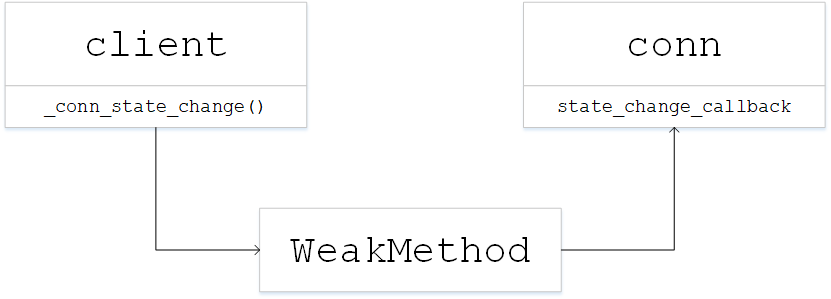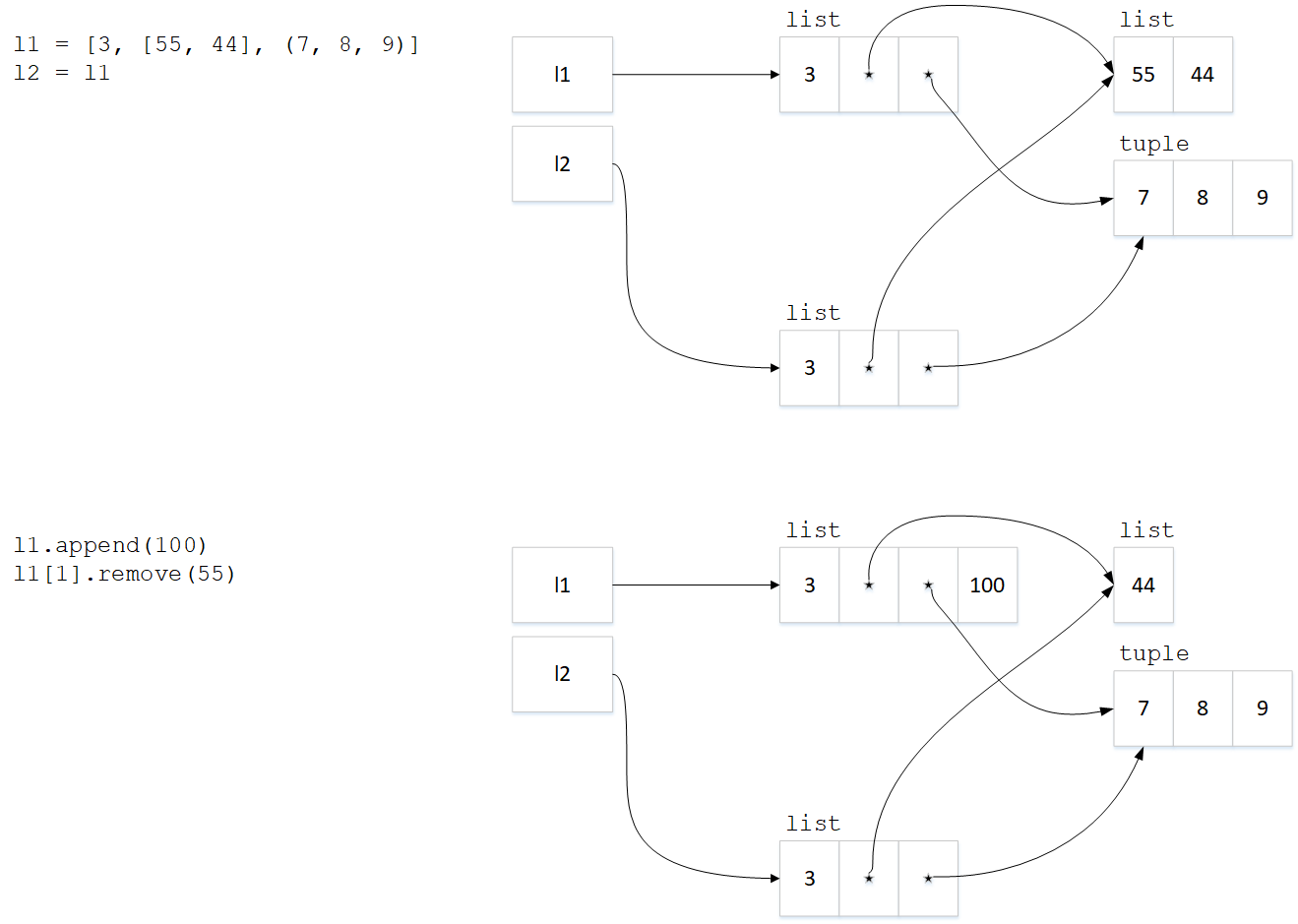在分析kafka-python源码时发现有个回调函数的处理怎么看也看不懂,生产者创建了一个client对象实例,client有一个方法_conn_state_change()。当建立连接时,使用conn实例来描述和管理一个连接,conn需要用到client的_conn_state_change()方法,因此在创建conn实例时要传入该方法,大致的上下文逻辑如图
代码如下1
2
3
4
5
6cb = WeakMethod(self._conn_state_change)
conn = BrokerConnection(host, broker.port, afi,
state_change_callback=cb,
node_id=node_id,
**self.config)
self._conns[node_id] = conn
为什么不能直接将该函数作为参数传入,而要通过另外一个类WeakMethod来封装一下,将返回的对象传入呢?
Weakmethod类的定义如下1
2
3
4
5
6
7
8
9
10
11
12
13
14
15
16
17
18
19
20
21
22
23
24
25
26
27
28
29
30
31
32
33
34class WeakMethod(object):
"""
Callable that weakly references a method and the object it is bound to. It
is based on https://stackoverflow.com/a/24287465.
Arguments:
object_dot_method: A bound instance method (i.e. 'object.method').
"""
def __init__(self, object_dot_method):
try:
self.target = weakref.ref(object_dot_method.__self__)
except AttributeError:
self.target = weakref.ref(object_dot_method.im_self)
self._target_id = id(self.target())
try:
self.method = weakref.ref(object_dot_method.__func__)
except AttributeError:
self.method = weakref.ref(object_dot_method.im_func)
self._method_id = id(self.method())
def __call__(self, *args, **kwargs):
"""
Calls the method on target with args and kwargs.
"""
return self.method()(self.target(), *args, **kwargs)
def __hash__(self):
return hash(self.target) ^ hash(self.method)
def __eq__(self, other):
if not isinstance(other, WeakMethod):
return False
return self._target_id == other._target_id and self._method_id == other._method_id
发现WeakMethod的定义中使用了weakref,通过查阅资料,才了解到这是python的弱引用。又经过一番查资料和写测试代码,才对python中的引用、拷贝和垃圾回收有了一定的理解
引用式变量
首先必须明确的一点是,类似Python或者Java语言中,变量只是一个标注,而不是对象本身。以一个例子来证明1
2
3
4
5a = [1, 2, 3]
b = a
a.append(4)
b
[1, 2, 3, 4]
对列表a的改动,结果b也发生了同样的改动,原因是a、b都只是同一个列表的引用,对引用的操作实质上是对对象本身的操作,如下图
默认做浅拷贝
这里有一个将代码运行转换成交互式动画的网站Python Tutor可以方便查看代码运行过程中到底发生了什么
Python默认的拷贝方式是浅拷贝,即只复制最外层容器,以下例子用来说明1
2
3
4
5
6
7
8
9
10l1 = [3, [55, 44], (7, 8, 9)]
l2 = list(l1)
l2
[3, [55, 44], (7, 8, 9)]
l1.append(100)
l1[1].remove(55)
print('l1:', l1)
('l1:', [3, [44], (7, 8, 9), 100])
print('l2:', l2)
('l2:', [3, [44], (7, 8, 9)])
l2是l1的浅拷贝,当直接对l1进行改变时(插入100),l2不会发生变化。但是对l1的第2个成员[55, 44]删除元素是,其变化会影响到l2,原理如图
深拷贝
如果要做深拷贝,使用copy模块的deepcopy()方法
弱引用
如果对引用操作不当,会导致对象无法被回收,内存泄漏,例子如下1
2
3
4
5
6
7
8
9
10
11
12
13
14class ReferenceTest(object):
def __init__(self, name):
print 'Object {} created'.format(self.name)
def __del__(self):
print 'Object {} destroy'.format(self.name)
def ref_test():
a = ReferenceTest('obj_a')
b = ReferenceTest('obj_b')
a.b = b
b.a = a
if __name__ == "__main__":
ref_test()
运行以上代码,结果是这样的1
2
3python referenct_test.py
Object obj_a created
Object obj_b created
正常来说,创建ReferenceTest类的两个实例a、b,当程序运行结束时,它们的引用计数变为0,会被Python的垃圾回收器自动销毁,而在销毁时会调用类的__del__方法,打印函数中定义的内容,而结果却没有打印。
因为这两个实例互相引用,其引用次数不可能为0,导致无法被回收。要解决该问题,就需要使用弱引用
weakref
Python提供weakref模块来处理弱引用,修改以上代码1
2
3
4
5
6
7
8
9
10
11
12
13
14
15
16import weakref
class ReferenceTest(object):
def __init__(self, name):
print 'Object {} created'.format(self.name)
def __del__(self):
print 'Object {} destroy'.format(self.name)
def ref_test():
a = ReferenceTest('obj_a')
b = ReferenceTest('obj_b')
a.b = weakref.proxy(b)
b.a = weakref.proxy(a)
if __name__ == "__main__":
ref_test()
运行以上代码,结果是这样的1
2
3
4
5python referenct_test.py
Object obj_a created
Object obj_b created
Object obj_a destroy
Object obj_b destroy
由于垃圾回收器在只有弱引用时也会将对象清理,因此obj_a和obj_b都被清理了
WeakMethod
回过头来看WeakMethod的用法,如果直接将函数_conn_state_change()传入conn中,而conn的返回实例又会被client._conns引用,形成了引用循环,因此需要创建弱引用对象,将弱引用对象传入到conn中